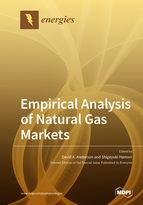Empirical Analysis of Natural Gas Markets
A special issue of Energies (ISSN 1996-1073). This special issue belongs to the section "C: Energy Economics and Policy".
Deadline for manuscript submissions: closed (31 March 2020) | Viewed by 29435
Special Issue Editors
Interests: environmental economics; resource economics; law and economics; crime
Interests: applied time series analysis; empirical finance; data science; international financeapplied time series analysis; international finance
Special Issues, Collections and Topics in MDPI journals
Special Issue Information
Dear Colleagues,
Recent developments warrant new analysis of the natural gas market. Abundant supplies of natural gas unearthed by hydraulic fracturing have altered the landscape for energy economics. Environmental, social, and governance (ESG) investments have accelerated the shift away from coal as the dominant source of electricity, in part because natural gas is the cleanest burning fossil fuel. The processing and liquefaction of natural gas remove most of its impurities, and compared to petroleum and coal combustion, natural gas combustion releases relatively little CO2 and NOX, among other pollutants. Its low environmental impact and reduced volume make liquefied natural gas (LNG) a popular source of energy during this time of transition between traditional fuels and newer options. Broad availability furthers the appeal of LNG. Unlike oil, whose sources are concentrated geographically, natural gas is extracted on six continents. In the United States, the shale gas revolution has made natural gas a game changer. Due to its many sources, even countries that import LNG can limit their supply-side risk by diversifying their suppliers. With this Special Issue, we will focus on empirical analyses of the natural gas market and its growing relevance worldwide.
Prof. Dr. David A. Anderson
Prof. Dr. Shigeyuki Hamori
Guest Editor
Manuscript Submission Information
Manuscripts should be submitted online at www.mdpi.com by registering and logging in to this website. Once you are registered, click here to go to the submission form. Manuscripts can be submitted until the deadline. All submissions that pass pre-check are peer-reviewed. Accepted papers will be published continuously in the journal (as soon as accepted) and will be listed together on the special issue website. Research articles, review articles as well as short communications are invited. For planned papers, a title and short abstract (about 100 words) can be sent to the Editorial Office for announcement on this website.
Submitted manuscripts should not have been published previously, nor be under consideration for publication elsewhere (except conference proceedings papers). All manuscripts are thoroughly refereed through a single-blind peer-review process. A guide for authors and other relevant information for submission of manuscripts is available on the Instructions for Authors page. Energies is an international peer-reviewed open access semimonthly journal published by MDPI.
Please visit the Instructions for Authors page before submitting a manuscript. The Article Processing Charge (APC) for publication in this open access journal is 2600 CHF (Swiss Francs). Submitted papers should be well formatted and use good English. Authors may use MDPI's English editing service prior to publication or during author revisions.
Keywords
- Natural gas market
- Global energy consumption
- Clean fuels
- LNG (liquefied natural gas)
- Henry Hub
- Spot prices
- Future prices
- Spillover
- Risk management
- Demand for natural gas
- Supply of natural gas
- Natural gas price elasticity
- Global natural gas trade
- Relationship between the price of natural gas and the price of oil
- Influence of Chinese demand on the world market
- Interregional natural gas trade
- Global natural gas trade
- Supply and demand imbalances
- Natural gas and the environment







